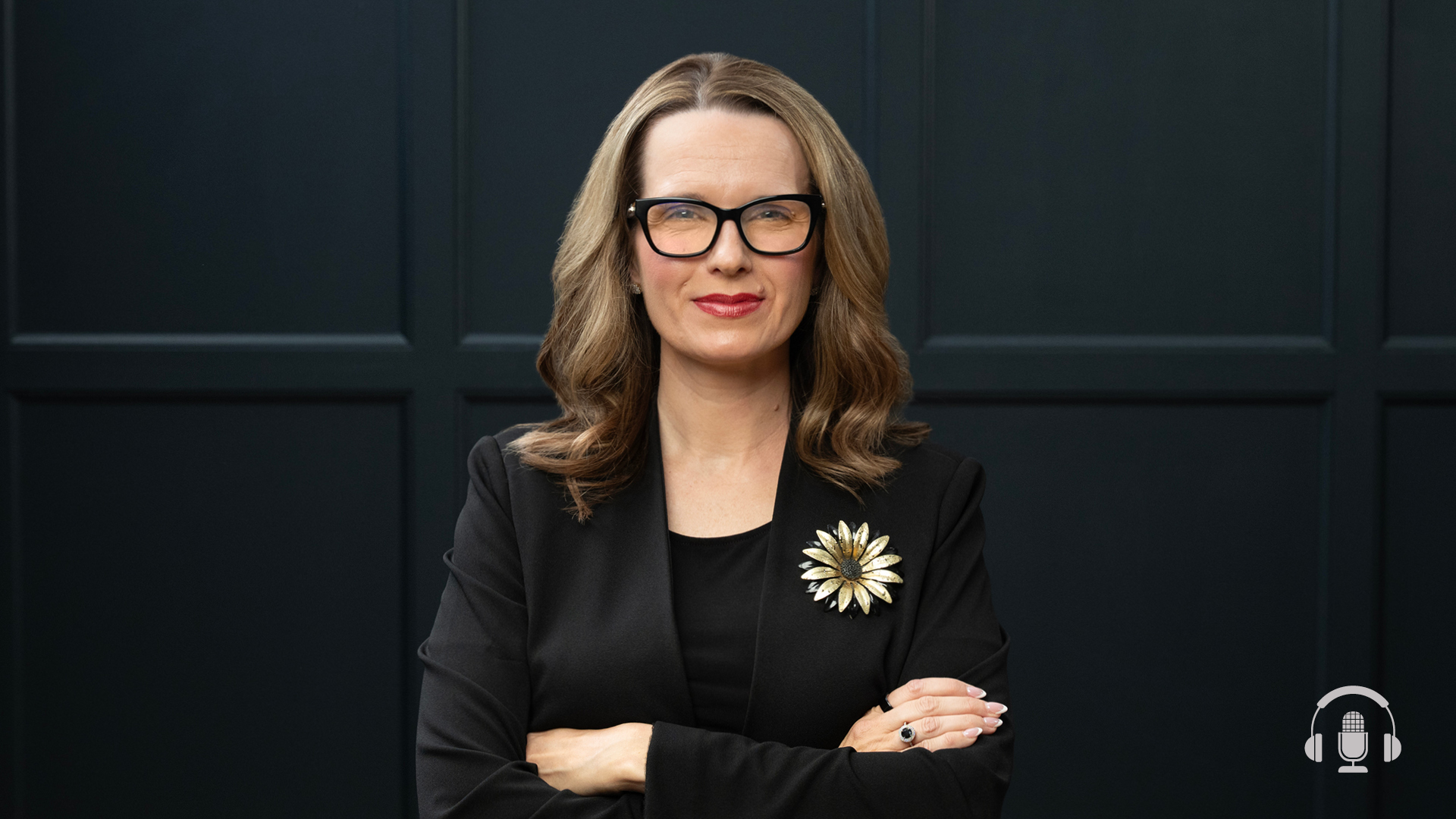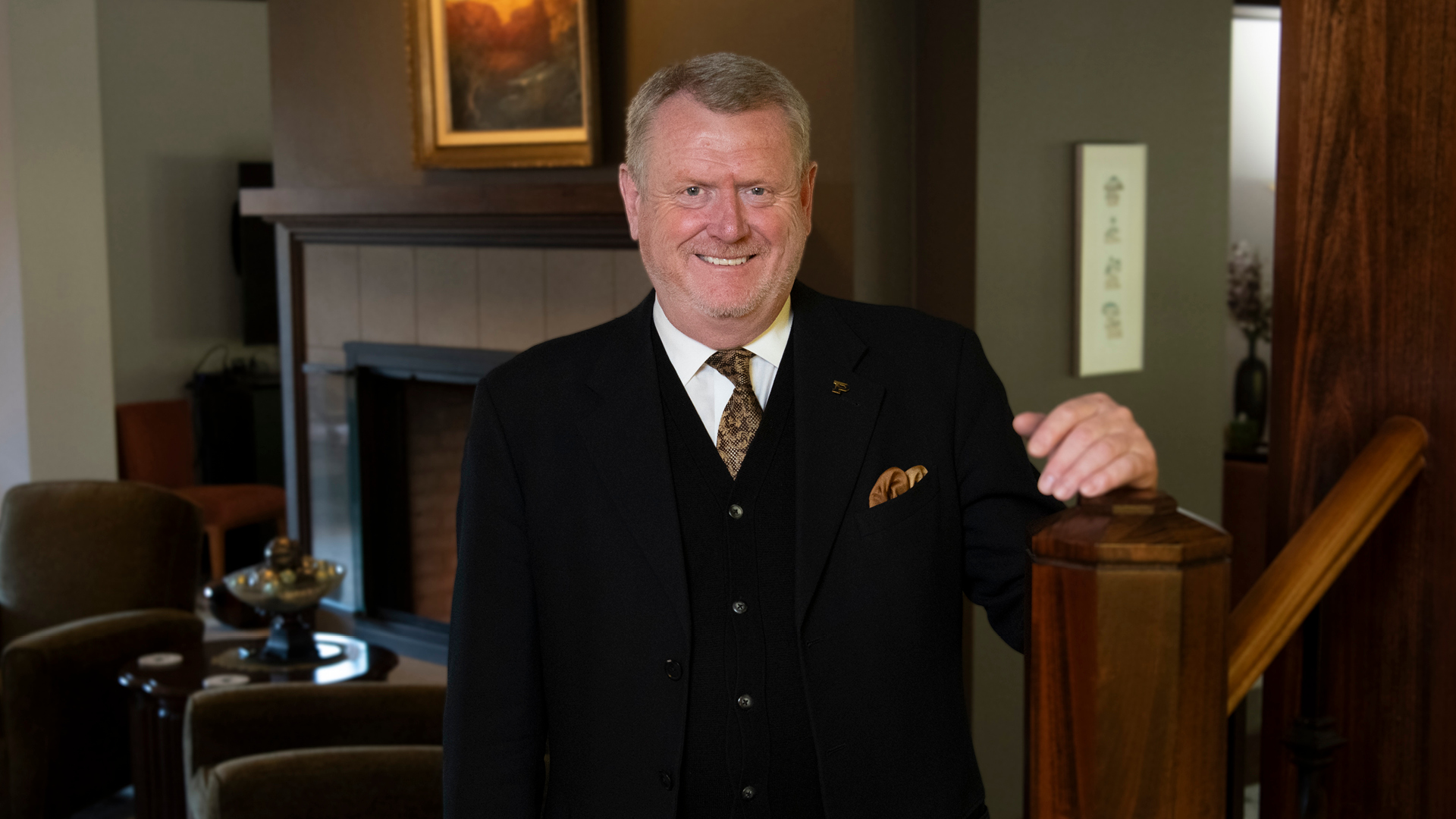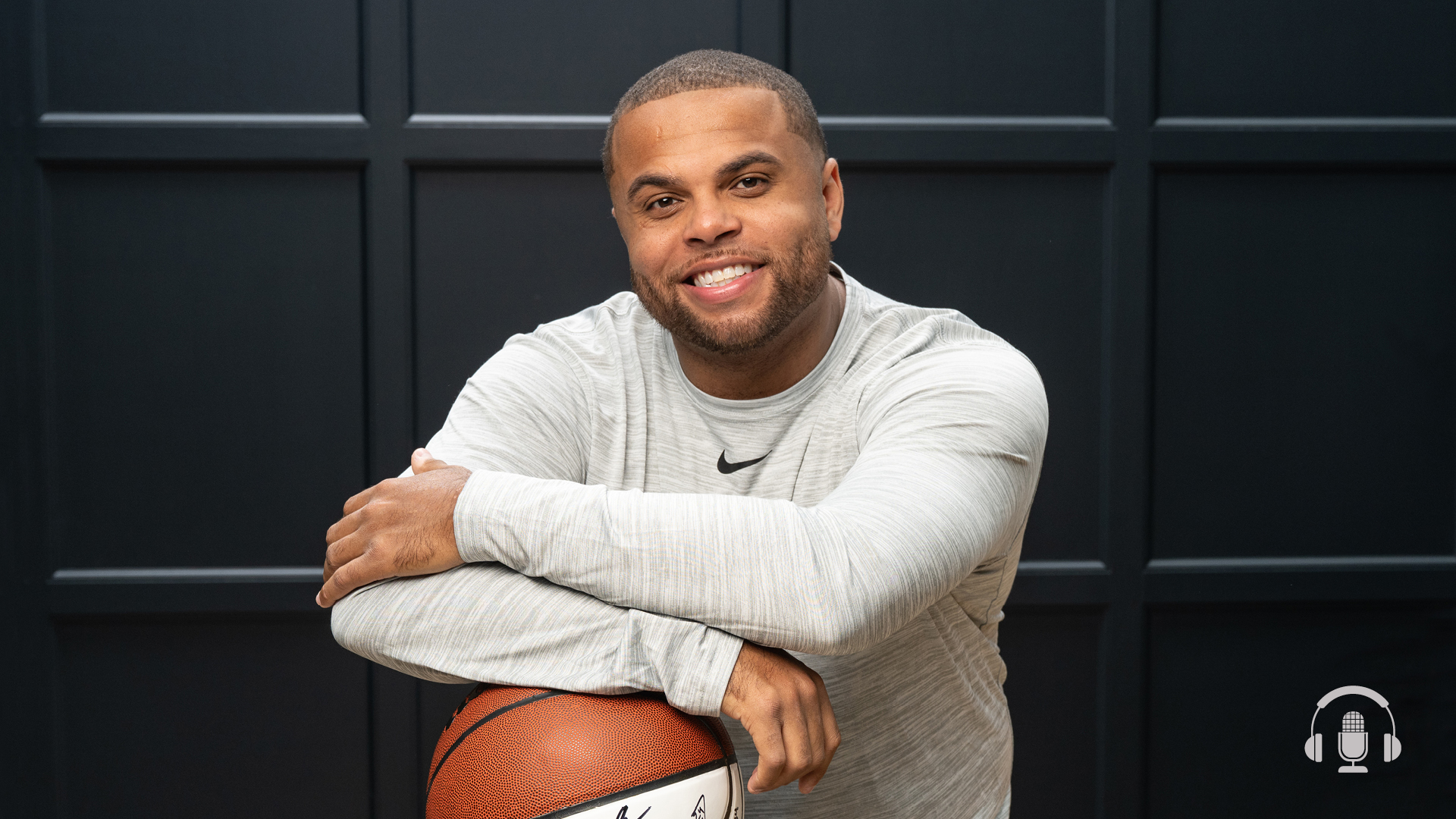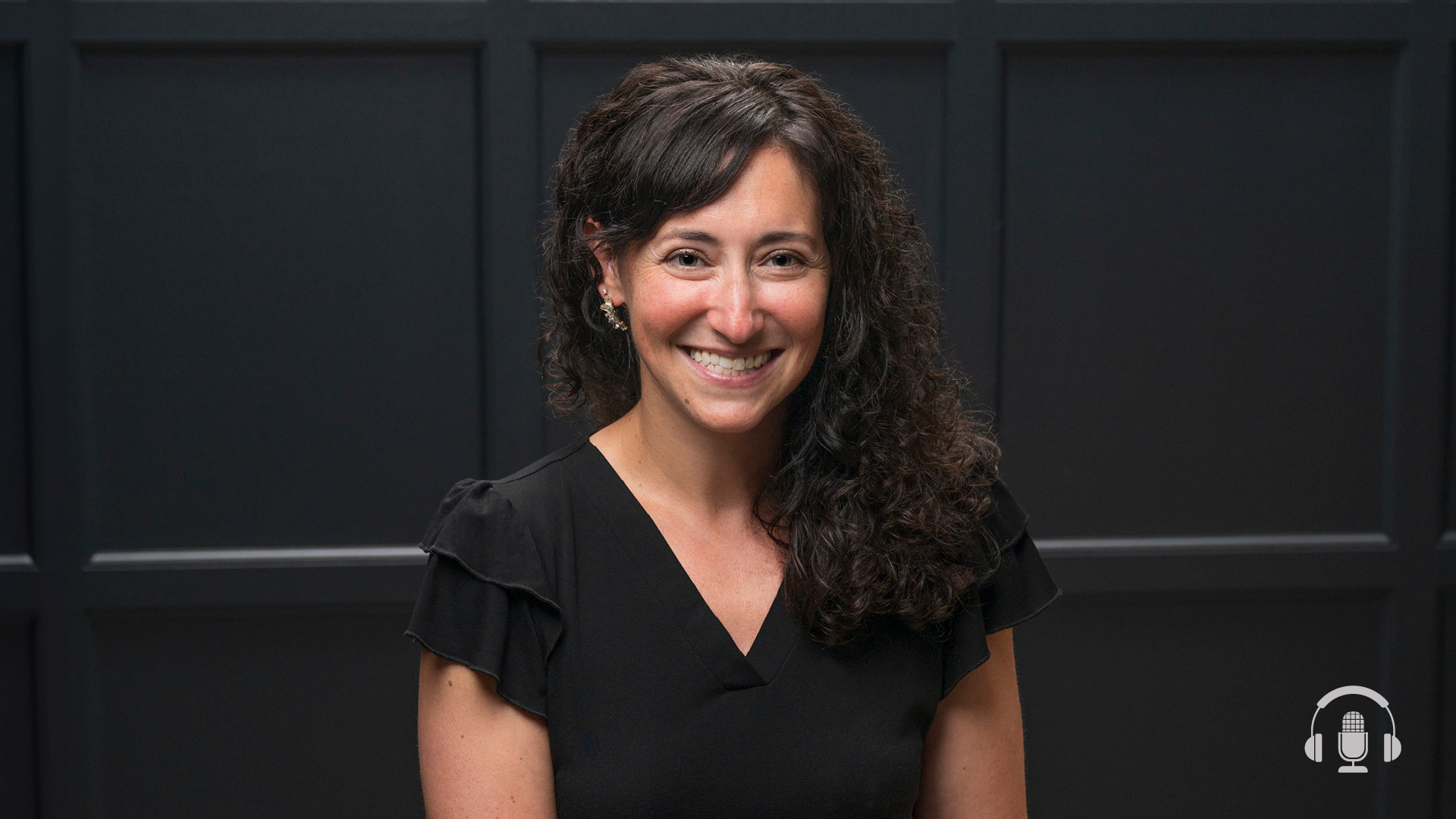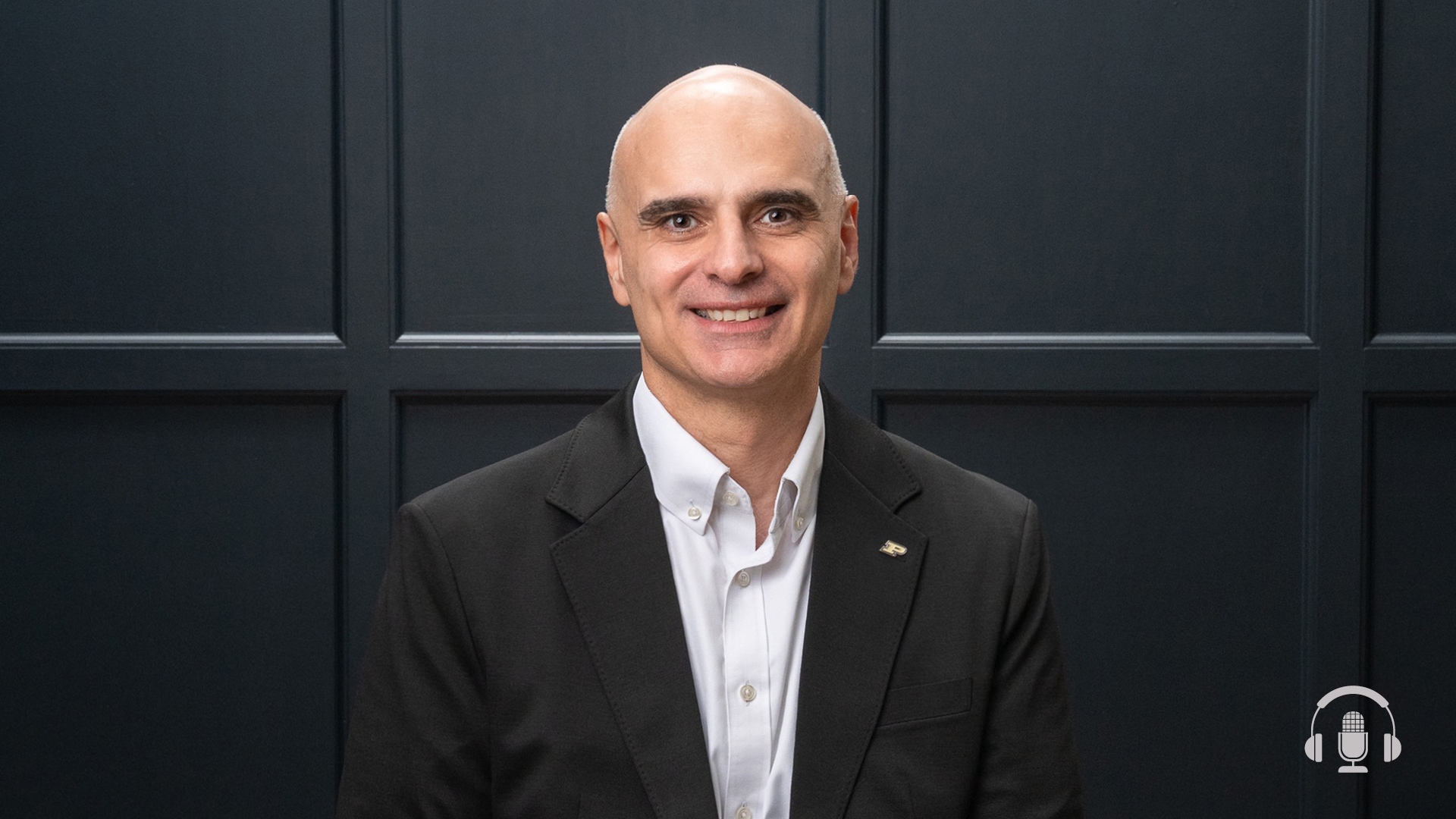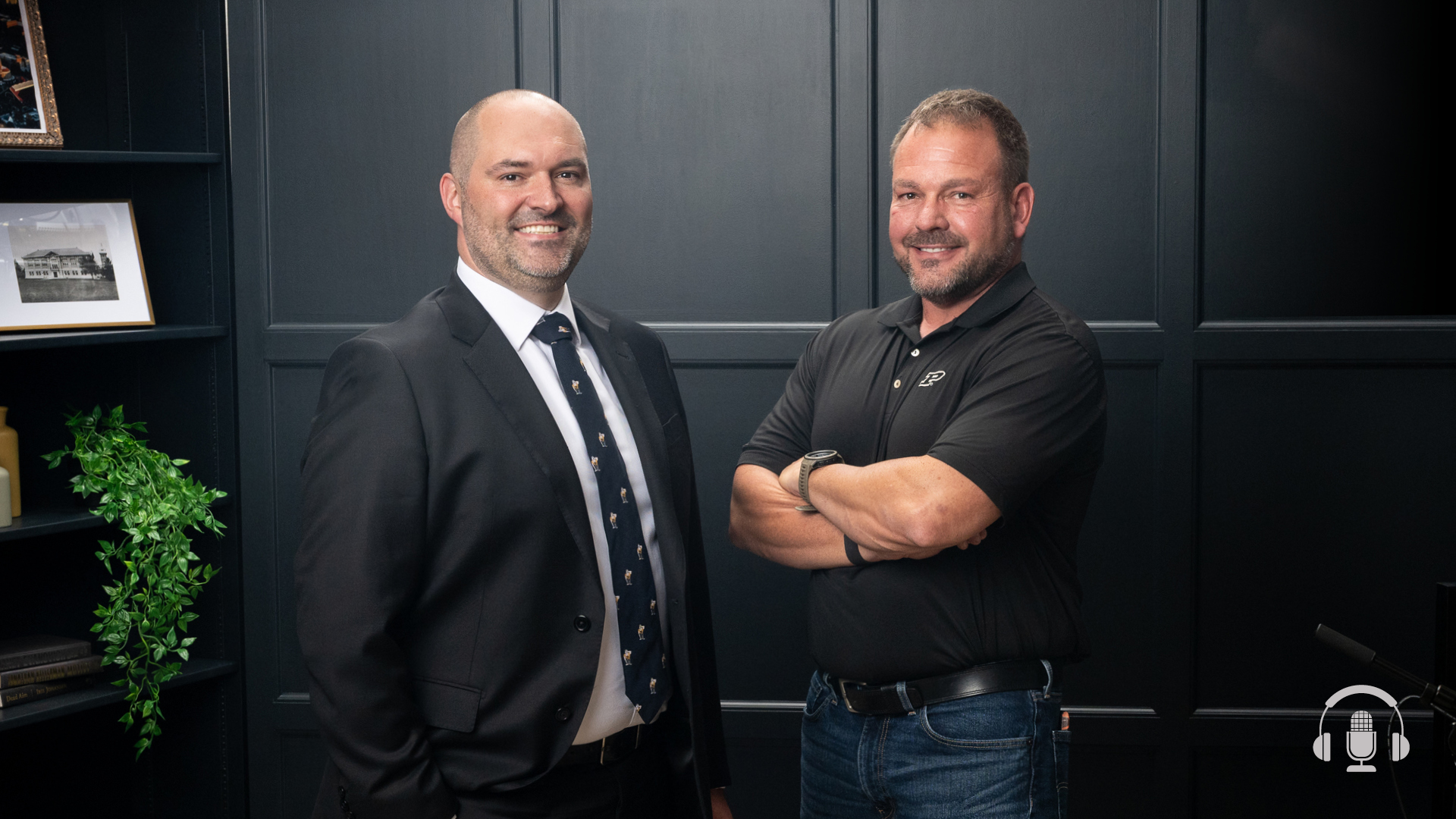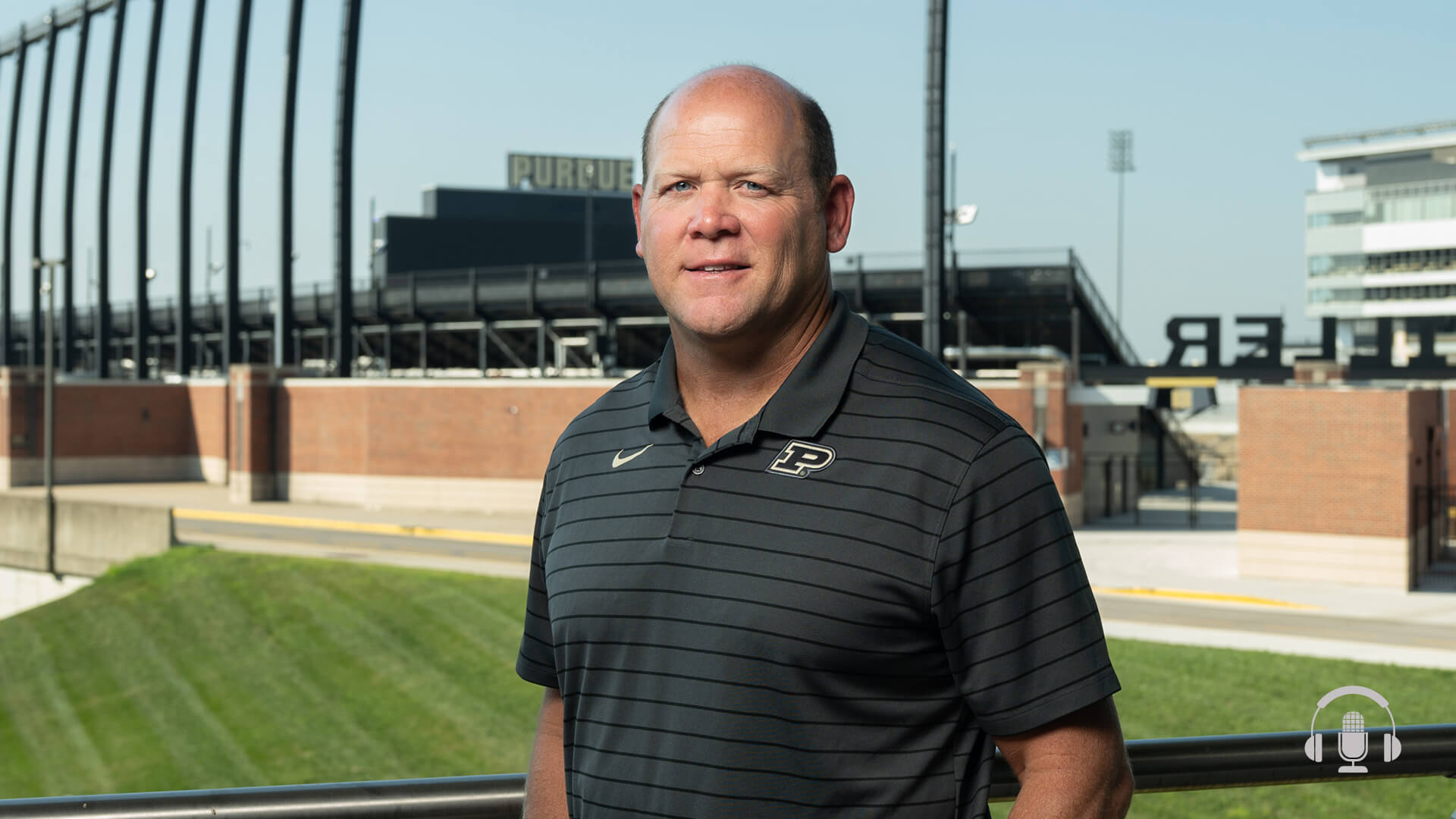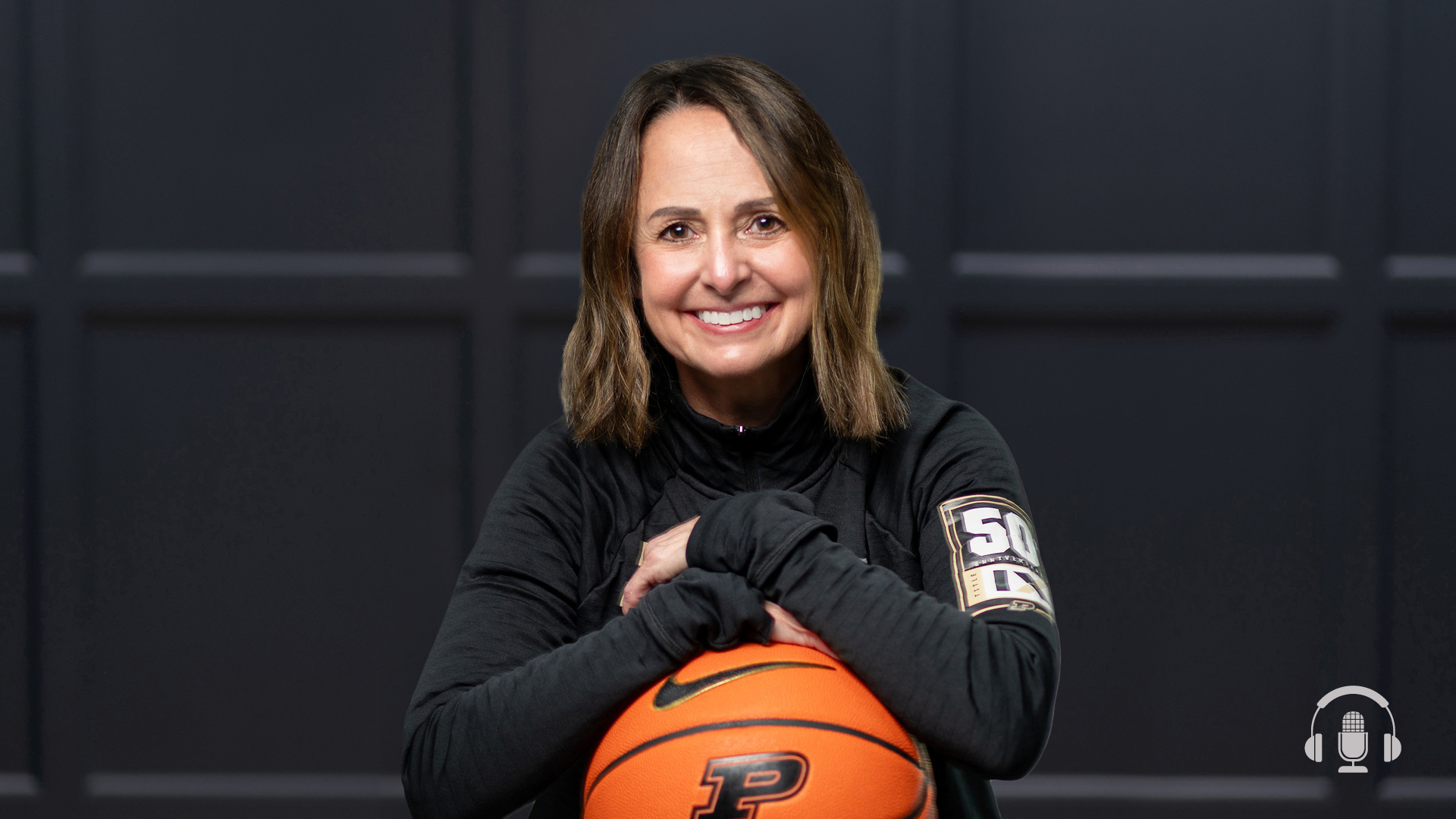Podcast Ep. 117: ‘Joy of My Life’ — Celebrating Jay Gephart’s Purdue ‘All-American’ Marching Band Legacy

In this episode of “This Is Purdue,” we’re talking to Jay Gephart, the Al G. Wright Chair of Purdue Bands & Orchestras, conductor of Purdue Wind Ensemble and director of the “All-American” Marching Band.
The prestigious marching band is known as the heartbeat of the university, with Jay serving as its fifth director. In this episode you will:
- Hear about the legacy Jay hopes to leave as he steps down at the end of the 2024 season.
- Journey around the world celebrating the incredible events where the “All-American” Marching Band has performed, such as the 2008 Beijing Summer Olympics; the St. Patrick’s Day Parade in Dublin; the Macy’s Thanksgiving Day Parade in New York City; and the Indianapolis 500.
- Discover some of Jay’s favorite band traditions — including the storied “Block P” formation, which has been used since 1907 when the band broke with the tradition of marching exclusively in military formations.
- Look back on the marching band’s greatest performances from over the years, like the beloved halftime shows, one of which even included an homage to an iconic movie franchise. Hint: Stormtroopers took charge of the World’s Largest Drum, and Purdue Pete Skywalker had to battle Darth Hoosier.
- Learn who makes the incredible alumni base of the marching band unique — from Neil Armstrong to Orville Redenbacher to the dedicated members who give back again and again and again.
Don’t miss this episode celebrating Jay Gephart’s leadership and impact on Purdue Bands & Orchestras.
- Learn more about Jay Gephart
- Learn more about the Purdue “All-American” Marching Band
- Learn more about Purdue Bands & Orchestras
- Learn more about the World’s Largest Drum
- Listen to the “This Is Purdue” episode “Celebrating 100 Years with the World’s Largest Drum”
- Purchase “Heartbeat of the University: 125 Years of Purdue Bands”
- Watch the full ‘Star Wars’ halftime show performance
Podcast Transcript
Jay Gephart:
This is Jay Gephart, director of the “All-American” Marching Band, and you are listening to This is Purdue.
Kate Young:
Hi, I’m Kate Young and you are listening to This is Purdue, the official podcast for Purdue University. As a Purdue alum and Indiana native, I know firsthand about the family of students and professors who are in it together, persistently pursuing and relentlessly rethinking. Who are the next game changers, difference makers, ceiling breakers, innovators? Who are these boiler makers. Join me as we feature students, faculty, and alumni taking small steps toward their giant leaps and inspiring others to do the same.
Jay Gephart:
Being part of this department and part of the marching band program has been the joy of my life. I never dreamed that I would be standing in front of that “All-American” marching band as its conductor. It means the world to me. When I look back at the incredible memories we’ve made, I can think about individual students I’ve taught throughout the years that were part of the marching band. So if that sums up what this program means to me, I would tell you that it has been the joy of my life to be part of this.
Speaker 4:
The Purdue University Band.
Speaker 5:
The biggest band in the parade of 2018. It’s their second time coming to Dublin. They were here five years ago as well. The Purdue “All-American” Marching Band from Indiana.
Speaker 6:
Ladies and gentlemen, boys and girls, the grand arrival of the 84th Macy’s Thanksgiving Day Parade.
Speaker 7:
Please welcome, the pride of the Boilermakers, the Purdue “All-American” Marching Band.
Kate Young:
In this episode of This is Purdue, we’re talking to Jay Gephart, the Al G. Wright chair of Purdue Bands and Orchestra, conductor of the wind ensemble and director of the iconic Purdue “All-American” Marching Band.
From their annual appearance at the Indianapolis 500, to the 2008 Summer Olympic Games, to performing at the Macy’s Thanksgiving Day Parade, and the St. Patrick’s Day Parade in Dublin, Ireland, the “All-American” Marching Band is part of famous celebrations across the world. And with alumni like Astronaut Neil Armstrong, the first man to walk on the moon, and popcorn legend Orville Redenbacher, the strong, devoted alumni base for this organization is unlike any other. The band is truly a pride point for Purdue University, and in this episode, we are celebrating Jay, the fifth director of the Purdue “All-American” Marching Band, as he steps down at the end of the fall 2024 semester.
He’s stepping down from the marching band position following the band’s final performance at the end of this year, but he will continue to chair at the band’s and orchestra’s department, direct the Purdue University Wind Ensemble, and conduct other indoor ensembles. You’ll hear Jay discuss how it feels to reflect on his legacy as band director, among other legendary former directors like Paul Spotts-Emerick, and Al Wright. Plus, he shares some of his favorite memories and performances from over the years, the stories behind the Rich history and traditions of the “All-American” Marching Band, and what makes this Boilermaker community so special and unique. Here’s my conversation with Jay.
Jay, thank you so much for joining us on This is Purdue. We are so thrilled to have you. You’re an iconic guest for our podcast and we know that our audience is just going to love this interview.
Jay Gephart:
Thank you.
Kate Young:
Let’s go back to the beginning. Tell us a little bit about your journey to Purdue. I’ve heard that you did not go to Purdue.
Jay Gephart:
That is correct. I think it’s a well-known fact that I’m an Indiana University grad. To be quite honest, the School of Music at Indiana University is one of the greatest schools of music in the world. So I got a great education at IU and it prepared me very well to do what I’m doing for a living. But initially I started teaching public school. I was a high school band director in South Georgia. That was my first job at a school called Hardaway High School. Then for the next nine years, I taught public school in Hobart, Indiana, in Wheeling, Illinois, and then at North Central High School in Indianapolis. That’s where I was before I came to Purdue.
Kate Young:
What led you here to Purdue in 1995?
Jay Gephart:
Well, I had always wanted to teach in higher education. Purdue’s in my backyard. I grew up in Montgomery County, about 40 minutes south of here, and so I knew the Purdue Band program. I’ve known about it my whole life. Just the opportunity for me to be part of such an historic program like we have at Purdue was a dream come true for me. So the appeal also to the position was that I was going to come to Purdue to conduct the Symphonic Band, which is the top concert band and the Symphony Orchestra, both of which I had a passion for. I never dreamed that I would stand in front of the “All-American” Marching band at some point during my tenure at Purdue. But that’s how I ended up here. It was, to me, being part of the Purdue Band program was just one of those iconic positions that I always dreamed of.
Kate Young:
So in 2006, you became the fifth director of the “All-American” Marching Band.
Jay Gephart:
Right.
Kate Young:
You said that that wasn’t your expectations when you first came to Purdue. So how did that come about? How did you feel when you attained that role?
Jay Gephart:
I taught at Purdue for 11 years before I became the director of the “All-American” Band. And so through those years I had the opportunity to work with marching band students during band camp. I taught many of those students in my concert bands during the second semester, so I knew a lot of the kids. But in 2006, two of my colleagues retired from Purdue and they were both directors with the “All-American” Marching Band. Bill Kissinger and Dave Lepla. When I was appointed director of bands, I spoke to my vice provost, Tom Robinson, and told him I’d really like to step into the role as the director of the “All-American” Marching Band. This college marching band was something that I thought would be a good fit for me, and I thought I would be a good fit for the band. I love college athletics, I love college marching bands. When I was a high school band director I was not a competition band director, which is something we don’t do at Purdue. So anyway, I thought it would be a good fit for me, and lo and behold, I found myself standing in front of the “All-American” Marching Band in the fall of 2006.
Kate Young:
What were your goals at the time when you stepped into this role in 2006?
Jay Gephart:
My number one goal was to maintain the rich traditions of the “All-American” Marching Band. At band camp one year, one of the first exercises we did with our student leadership team is had them populate a whiteboard with all the traditions of the Purdue “All-American” Marching Band, and in about five minutes we had over 50 traditions on the whiteboard.
Kate Young:
Wow.
Jay Gephart:
And so tradition is very important to this band program. So that was my number one priority, was to maintain these traditions.
Second priority was to make sure that the “All-American” Marching Band was an incredibly fine playing band. I wanted this college marching band to sound like a college marching band. And it’s not that they didn’t before, but with my background as a concert band director and an orchestral conductor, I thought maybe I brought maybe a different perspective to the music. And so that was a priority for me. My third priority was to make the “All-American” Marching Band nationally and internationally visible. And this was something that my predecessor Al Wright did beautifully. Al took the band to South America and Europe and Canada. The marching band was known throughout the world as one of the greatest college marching bands, and I wanted to do that as well. So we did. We started traveling nationally and internationally, and the rest is history. It’s been a great run.
Kate Young:
Tell us about some of those traditions that you saw as the students were writing them on the whiteboard.
Jay Gephart:
You can divide some of our traditions by the director who created them.
Okay. So you go back to our first director, and his name was Paul Spotts Emrick, and Spotts was an incredible innovator, even though his degree was in engineering. So he started as a student conductor of the “All-American” Marching Band. Then he became the conductor of the marching band and an engineering faculty member. But while Spotts was here, he brought things to the band like the Big 10 Flags, so we were carrying a flag representing the colors of every Big 10 school. And of course, back in those days there were 10. There were 10, and I believe University of Chicago was one of the original Big 10 schools.
Spotts was also responsible for purchasing the world’s largest drum in 1921. So throughout our history, the world’s largest drum had been an icon for Purdue and also part of the brand of the “All-American” Marching band. When Al Wright came to Purdue, Al created the Golden Girl twirling position. He also created the other solo twirling positions like the Girl in Black and the Silver Twins. He brought to our pregame show, what is known as I Am an American, and those are just a few of, I think, the more significant traditions that we had at Purdue that I knew I had to maintain moving forward. Those are too important to our fans.
Kate Young:
Well, and football would not be the same without the “All-American” Marching Band. So what is your personal favorite part of these home football games?
Jay Gephart:
My personal favorite is the pregame show, because the pregame show is where you find all the rich traditions. The marching style, all the traditional formations we’ve done for years and years like The Block P. We were the first band to break ranks from a military band to create a formation on the field, and that formation was the Block P. When you watch our pregame show, not a lot has changed over the years. We do the same Block P, the same floating Purdue formation. We create the Boilermaker special on the field, and of course, we’ve been doing I’m an American since the late ’60s, so I love our pregame show. That’s one of my favorites.
Kate Young:
Jay goes on to explain more about how the band members breaking rank to form that Block P back in 1907 changed everything for marching bands across the country.
Jay Gephart:
The band back in those days performed for the ROTC program here, and so whenever the ROTC members were on the march the band played military marches and they would march up and down the street or up and down the commons or whatever you wanted to call it. And then when we broke ranks and created the Block P, everything changed.
The story goes that Spotts looked up and he saw a flock of geese flying overhead in a V formation, and he thought, “Well, if the geese can fly in a perfect V formation, why can’t the band create a formation on the field?” And so we did. We made the Block P. Then other university programs on the heels of Purdue started to do the same thing. Every time I watch any competitive marching band or college marching band, I think about the impact that Spotts Emrick had on the world of marching bands by creating that Block P the first time he did it.
Kate Young:
By the way, as I was gathering some research from the book Heartbeat of the University, 125 years of Purdue Bands by John Norberg, I noticed that the Block P has been formed in more places than just on Purdue’s campus. It’s been recreated by band members and alumni in some interesting spots such as the Grand Canyon, underneath the ocean and Hawaii, and even on top of Mount Fuji in Japan. You’ve talked about the legacy, the tradition, but you’ve also brought a lot of new things to the band. Tell us a little bit about those new things that you added and why you thought that was important.
Jay Gephart:
I’ll start this discussion with the Big 10 flags, and remember Spotts Emrick brought the Big 10 flights to the band back in the 1920s, then they went away for quite a long time. I brought those back to the band because I thought just the visual pageantry of all the colors of the Big 10 flags in front of the band was spectacular, and I wanted those to exist again.
In the pregame show we started a formation that represents our net tillers boiler up that wasn’t part of our pregame show. So during Fighting Varsity we spell “Boiler Up.” We also now create a formation of the world’s largest drum in our pregame show, which is a very unique tradition for Purdue. And of course there’s a backstory to that about when we traveled to Notre Dame just a few years ago and we couldn’t bring the drum into the stadium, so now we just put it on the field.
Kate Young:
We remember that well.
Jay Gephart:
Yeah, I’m glad. Well, that big bass drum is such an important icon that we thought it would be appropriate to put a formation of that onto the field. So those are some new things I brought to the table with regard to our pregame show. As far as halftime is concerned, when my team and I get together to design halftime shows for the “All-American” Marching band, I tell them virtually nothing is off the table. We bring up great ideas and we bring up wacky ideas, and then we vet these ideas and try to think about what music would be appropriate. So during my 19 years, we’ve had some incredibly fun and innovative halftime shows that I think I would consider to be a hallmark of my tenure here as the marching band director.
Kate Young:
Can you tell us about a wacky idea that was maybe cut?
Jay Gephart:
Well, actually there was a wacky idea that we ended up doing, but we had to do a lot of work to make it happen. We wanted to do a spoof on Star Wars. Okay, so we did.
Speaker 4:
Pete Skywalker. Since 1869, the Boilermakers have been the guardians of peace and justice in the Republic of Indiana, but recently, denizens of the evil empire have reared their cream and crimson heads. Our nemesis, Darth Hoosier has captured our golden Princess Alexa and imprisoned her in the Death Sphere. Use the force, Pete Skywalker. Save our Golden Gold from Darth Hoosier.
Speaker 8:
Pete Skywalker, hear my challenge. The Empire’s banners are flying, and your petty resistance is meaningless to Emperor Tom Palpacream. Give up now, or your girl of gold is as good as gone.
Speaker 9:
Pete Skywalker, you’re my only hope.
Jay Gephart:
The creator of the Death Star was a character by the name of Darth Hoosier, and so the spoof was an Indiana University spoof when we had some good laughs with that. But we had to tread lightly when it came to poking fun at my alma mater a little bit, but it was a fun halftime show.
Kate Young:
I am telling you all, you have to see the Star Wars performance on YouTube. Purdue Pete is fighting Darth Hoosier with lightsabers, and the Golden Girl is inside the big bass drum with Princess Leia-style earmuffs on her head. It is incredible. We’ll link this YouTube video in the show notes for you.
Jay shares more about other memorable performances during his time as director and reflects on his career as both a teacher and band director.
Jay Gephart:
I also wanted to do a Marvel Comics halftime show, but I wanted all the superheroes to come from the Purdue West Division, and I wanted all the villains to come from the Purdue East, and we just couldn’t quite make that work. So that was another wacky idea. We also wanted to do a halftime show based on the game show The Price is Right, and so we had to decide which segments of The Price is Right would really work. But we ended up putting that halftime show on the field with Plinko and all the other Price Is Right components, and the crowd absolutely loved it. But I would tell you that we also poked a little at our Hoosier friends during that halftime show too.
Kate Young:
You have to.
Jay Gephart:
Yeah, of course. Right.
Kate Young:
So you’re approaching this fall 2024 semester will be your last as the director of the band. How do you think you’ll feel that first football game you’re on the field? Kind of the first of the last.
Jay Gephart:
It’s just been an emotion-filled summer.
Kate Young:
I bet.
Jay Gephart:
I broke the news to my faculty last spring, and then I told my students on the weekend of the Indianapolis 500, and that was a difficult discussion. Very emotional for me. When I think about my tenure in this position and I think about it lasting 19 years, it went by just like that. This year is not only my final year as the director of the “All-American” Marching Band. This represents my 30th year at Purdue and my 40th year as a teacher. As I was discussing this recently with my wife, I told her, “I can remember vividly my first day of teaching in 1983.” So time goes by quickly, and I think when I stand on that ladder and conduct the Purdue Fanfare pregame, I think the memories will flood back. I look forward to that to some degree, but also I’m sure this season is going to be filled with some melancholy feelings, quite frankly.
Kate Young:
Jay shares some of his favorite traditions as the Purdue “All-American” Marching Band’s director, including how the band became a household name at the Indianapolis Motor Speedway, first performing at the Indianapolis 500 back in 1919, and he goes on to discuss some of the incredible places and iconic events the band has traveled to both nationally and internationally.
Jay Gephart:
My favorite tradition as the director, I think is the Block P. That’s my favorite tradition. Every marching band you look at today that creates a formation on the field from every high school band to college marching band had its roots here at Purdue. So we’ve been forming that Block P for well over 100 years. The reason I think it’s my favorite is during our alumni band reunion, that’s the final formation we make with the undergraduate band on the inside of the P, and then all the alumni come around and form the Block P, and they’re thrilled. The alumni are thrilled to come back and create that formation on the field with the undergrads. It means so much to our students. And one other tradition that I think is probably a close second for me is our affiliation with the Indianapolis 500. We’ve been the official band of the Indianapolis 500 for over 100 years. I have spent 28 Memorial Days at the racetrack. It was funny, during COVID when they didn’t run the race, my wife said, “Well, what do we do this weekend?” And I said, “Well, we’ll do like everybody else. We’ll have a cookout, and those kind of things.” We hadn’t experienced it for almost 30 years. But what a rich tradition that is to be part of something so unique. What other college marching band in the country has something like the Indianapolis 500 they they’re associated with?
Kate Young:
Yeah, it’s a staple of that race. What do the students think about being part of that?
Jay Gephart:
Just to show you the commitment on the part of our students, they have to pay their own way back to participate in the 500. Final exams are typically two to three weeks before the 500, and this past year we had I think 300 of the 390 students come back for the 500, paying out of their own pocket. They love the experience, but they also know how important that tradition is to Purdue, and they want to keep that going.
Kate Young:
They want to keep it perfect.
Jay Gephart:
They do. They do.
Kate Young:
So the Indy 500 is closer to home here in Indiana, but you’ve had performances all over the world. In 2008, the All American Marching Band performed at the Olympics in Beijing.
Jay Gephart:
We were part of the pre-ceremonies for the Olympics in Beijing. That was our first major travel.
Kate Young:
How did all that come about?
Jay Gephart:
I knew the opportunity existed, and so I wrote a letter and applied and they accepted us. They invited us to come.
Prior to that, whenever Al took bands abroad, he would take a small component of the marching band to places like Venezuela and Colombia. He might take 100 students. And so I decided we’re going to open this up to anyone who wants to go. And lo and behold, that first trip to China, we had 275 students.
Kate Young:
Wow.
Jay Gephart:
Sign up to go on that trip. And that was the beginning of our brainstorming about different locations we might take this band. That China trip was indescribable. It really was. We performed in a concert hall in front of hundreds of military musicians from China, and the first piece we played was the Chinese national anthem. And so of course, all these military men and women stood at attention during their national anthem, and then we played the National Anthem of the United States.
Kate Young:
Oh, wow.
Jay Gephart:
And all of these Chinese military continued standing at attention while we played our national anthem. It was powerful. It really was. And then we performed a concert at the Great Wall of China, which is also spectacular.
Kate Young:
That’s incredible. You got to go to LA 2028, right?
Jay Gephart:
Yeah, that would be great, wouldn’t it?
Kate Young:
You can go as a volunteer.
Jay Gephart:
Yeah.
Kate Young:
Okay. So in 2010, Purdue became the first Big 10 school to perform at the Macy’s Thanksgiving Day Parade in New York City. Tell us how that came about and how you were able to organize that big trip.
Jay Gephart:
Well, one of my colleagues at the time is a man by the name of Max Jones, and Max was an assistant director at Purdue. But prior to coming to campus, he was the director of bands at Concord High School in Elkhart, Indiana, and the Concord Band was a perennial state champion marching band. They had participated in the Macy’s Parade on two or three occasions, and Max encouraged me to think about applying to perform at Macy’s, and I thought, “Well, no other Big 10 school’s done this. What would it take for us to go?” So I submitted an application and lo and behold, we were accepted.
Kate Young:
These stories keep happening.
Jay Gephart:
I know. We were accepted. But the application was two years before the actual parade. That’s how the Macy’s Parade works. So we had two years really to plan and prepare for this performance. So on Monday before Thanksgiving we loaded buses here in West Lafayette and we headed east. We drove through the night, ended up in New Jersey early in the morning Tuesday, the students started doing their touring of New York, and Wednesday night before the parade, the students got in their uniforms and we loaded our buses. We drove to the Macy’s store on 34th Street, and we had a 3:00 A.M. rehearsal.
Kate Young:
Oh my goodness.
Jay Gephart:
Now, the NBC requires all the participating bands to rehearse in front of the store in the middle of the night. I think what they’re looking for, there’s that emblem, that Macy’s emblem on the street, and I think simply they just want to make sure each band is centered on that logo. So we did our routine one time and we hit our marks and so forth, and the producer said, “Purdue, that’s all I need.” And I turned to the producer and I said, “Don’t we have 20 minutes to rehearse?” And he said, “Sure.” And so I yelled, “Run it back.” And so we did the Macy’s routine as many times as we could in 20 minutes. We loaded the buses, slept on 8th Avenue for a while, and then we led the Macy’s Thanksgiving Parade the next day. That’s probably one of the highlights of my life, is to be part of the Macy’s Thanksgiving Day Parade with this band. It was just a very special moment for all of us.
Kate Young:
That’s incredible. We’ve talked about all these different places. Tell us about the St. Patrick’s Day Parade in Dublin, Ireland.
Jay Gephart:
We have been in the St. Patrick’s Day Parade three times now. 2013 was our first adventure to Ireland. So during spring break, the band traveled around the Republic of Ireland the first part of the week and then we landed in Dublin. The St. Patrick’s Day Parade in Dublin is, I think, unlike most St. Patrick’s Day parades anywhere in the world. It’s a very intimate parade. The crowd is really right down on top of the parade participants. We were the final group in the parade. So as we were marching we had, I think, 375 students in that parade. The last four minutes of the national broadcast, the broadcaster said, “Let’s just sit back and listen to this brilliant performance by this band from Purdue University.” And so for four minutes we had national coverage without any kind of commentary or talking. Just listening to and watching the “All-American” Marching Band perform in that parade in front of hundreds of thousands of people from all over the world. All over Europe, they come to Dublin for that parade. So we had such a successful time in 2013 we wanted to do it again, so we went again in 2018, we went again in 2023. I wouldn’t be surprised to see our band in the parade in 2027. This is the beginnings of another one of those traditions that I think we’d like to keep going.
Kate Young:
Ireland, Indianapolis, China. What is your favorite place that you’ve taken the band and why?
Jay Gephart:
Well, my favorite place is New York. It’s to the Macy’s Parade, for all the reasons I mentioned, but it’s a very different experience. You march the parade before you see the national television broadcast. So we started the parade at 9:00 A.M. and we marched throughout the streets of New York and we ended up down on 34th Street. Then everybody breaks ranks and we get organized and we line up right there in front of the Macy’s store. They literally give you a green flag when it’s your turn to march, and we had a minute and 20 seconds to do our performance. So we stormed down the street and we played our performance, and as we’re marching off the street, we’re playing Hail Purdue, and I felt in my pocket my cell phone started to explode. It was buzzing left and right, and people were sending me text messages from all over the world about our performance at Macy’s. I think the national audience for the Macy’s Parade is 50 million people. That was a very special performance for us, for sure.
Close seconds for me have been each one of the bowl performances we have done with Purdue football. I’ve traveled with the band and Purdue football to Orlando. We’ve been to San Francisco, of course, we’ve been to Detroit twice. We’ve been to Texas. Those bowl experiences are very special, especially for the students. Those would be close seconds behind our Macy’s performance.
Kate Young:
I love it getting the band out there on the national and international stage.
Jay Gephart:
Yeah, you’re right, for sure.
Kate Young:
We’ve talked about the band, we talked about traditions. It’s just such an iconic thing at Purdue University. Why do you think Purdue’s Band is different from other universities across the country?
Jay Gephart:
I’ve had that conversation with many of my colleagues throughout the country. What makes Purdue so unique? You can talk about the fact that we have no school of music here. We do have a music degree at Purdue now, but there’s not a full-blown school of music. Everyone who’s been in our department, every participant of the “All-American” Marching Band does it just because they want to and they love it. I think that plays into the success of our program, but I also think we can do some things with our band at Purdue that other universities can’t.
So beginning back in the Spotts era and the Al Wright era, the band started traveling. They took trips to South America, and as I mentioned, to Japan and Canada and Europe. And we have all of these rich traditions that many bands in the country, they’re lucky if they have won. So I think that’s what really sets our band apart from the other college marching bands in the country, and what makes it so special to become a member of the “All-American” Marching Band. I think that’s the most important part of it is just the rich tradition of this department.
Kate Young:
We’ve discussed your teaching career. What does it mean to you to teach Boilermakers in music? What is your favorite part about leading the students, interacting with them, that mentorship element that you have as the director?
Jay Gephart:
Well, our students, they’re participating in music as an avocation. And with that, if we do our job right here, if we teach music and we teach the value of the arts to our students, they will be the school board members and the members of symphony and community bands and boards of directors and so forth that can really make an impact on the arts. I think that that’s the future. Teaching the non-major.
I wish many of my colleagues around the country could understand the importance of that, especially in those locations where they have schools of music, because I think the proof is in the pudding, and at Purdue our students go out and they become members of these community bands and orchestras, and they want to continue playing music throughout their lives. That’s what’s important to me about teaching our students at Purdue.
Now, we also give some pretty tremendous concerts here, so just the thrill of performance is also another element of that. But I would be very disappointed if our Purdue students left here and did not become strong advocates for the arts wherever they land.
Kate Young:
While we’re on this topic of Boilermaker students, the Purdue “All-American” Marching Band alumni are some of the most devoted Purdue alumni, and they’re always among some of the biggest donors during Purdue Day of Giving. I asked Jay why he thinks these alums are so committed to Purdue.
Jay Gephart:
I’ve never seen anything like it at another university, quite frankly. I was a member of the Indiana University Marching Hundred for three years when I was a student. At IU they have an alumni band that happens every year, and they may get a 100-150 people to come back. But at Purdue we get hundreds of alumni to come back to our alumni marching band reunion every other year. The thing about our alumni that probably hit home with me more than anything was 2009, my wife Carolyn died of breast cancer. We talk about the Purdue Band family regularly, but it isn’t until something like that happens that you realize what that really means. And in the days following her death, I received email messages and phone calls and then received cards in the mail from Purdue Band alumni that I knew and many that I had never met in my life. That’s what the alumni base means to me. It truly is a family here. They really showed it in 2009 when I went through that tragedy.
Kate Young:
It’s a special base that’s just so committed to Purdue and the band.
Jay Gephart:
They are. They’re committed to this band. Their experiences in the “All-American” marching band were such that as they’ve gotten older, they want to come back and relive that at homecoming, but our alumni are also very generous. We’re sitting here in Hagel Hall right now, and this facility would never have happened had it not been for the generosity of alumni from Purdue bands.
Kate Young:
Our podcast team interviewed Jay inside the Mark and Sharon Hagel Hall. The four-story building which opened in 2022, is named for Mark and Sharon in honor of their $10 million leadership gift. Mark was a member of the “All-American” Marching Band during his time at Purdue. Jay expands on the importance of this new home for Purdue bands and orchestras, which also proudly displays the world’s largest drum.
Jay Gephart:
When Purdue bands moved into the Elliott Hall of Music over 80 years ago, the department was still part of the military. I think we had maybe 120 men in the department. Through the decades, the department just continued to grow and grow and grow and course offerings were more than just marching band. We had jazz program and we had orchestras and concert bands. When I came to Purdue in 1995 there were about 600 students in our department, and by 2013 we had grown to almost 1000 students.
It became apparent that the Elliott Hall of Music facilities could not accommodate our continued growth. The facilities were very dated. We needed space not just to grow as a department, but we needed modern facilities that could provide us the best environment to teach. That’s why it was important for us to pursue Hagel Hall. Our enrollment this fall, in 2024, we anticipate will be close to 1400 students. So to grow from 600 in 1995 to nearly 1400 students today, I think that demonstrates why we needed to bust out of the Hall of Music and come to this beautiful space.
Kate Young:
What has been the impact of this new home over the past couple of years for the students?
Jay Gephart:
I think it’s been immeasurable. The sheer fact that we can have rehearsals in state-of-the-art facilities, that are acoustically designed specifically for orchestra or for concert band, I think that’s important. So I believe the quality of our performances is increasing year after year now that we’ve been in this space.
We also have 14 practice rooms in this building. When we were at the Hall of Music, we had two.
Kate Young:
Quite the difference.
Jay Gephart:
Yeah, when it comes time for auditions, ensemble auditions for the next semester, the practice rooms are busting to overflowing. There are kids in there throughout every day, well into the evening. As part of the Hagel Hall Construction, we also have the Hall “All-American” Marching Band Complex located on West Third Street across the street from Shreve, and that also has transformed the “All-American” Marching Band’s ability to rehearse. We house the entire marching band at Hall. We’ve added 26 minutes to our rehearsal every day by breaking the tradition of having to march from the Hall of Music down to the drill field and back. The campus community was pretty disappointed by that, but to have 26 extra minutes of rehearsal every day has changed our marching band for the better.
Kate Young:
You’re so beloved in this community. Everyone knows your name even if you were in the band or not. What do you hope that your legacy will be as you step down as director?
Jay Gephart:
As the director of the “All-American” Marching Band and director of bands here, I’m merely a steward of this program. I want my students, of course, to remember the wonderful musical experiences they had and the great halftime shows we performed. But most importantly, I want them to remember this beautiful family that is Purdue bands and orchestras. What I want my legacy to be is that I fostered an environment of caring, of this kind of family atmosphere, that I want to be part of. When I leave here as the steward of the “All-American” Marching Band, I hope my successor will continue to do that very thing because I know how important it is to my students.
Kate Young:
Tell us about your plans for the future. How do you want to continue to impact Purdue?
Jay Gephart:
I will step down as the director of the “All-American” Marching Band, but I will continue as the Al G. Wright chair of Purdue University Bands and Orchestras, and I will also continue to conduct the Purdue Wind Ensemble. I’m approaching official retirement age soon, and I have six grandchildren.
Kate Young:
Oh.
Jay Gephart:
I want to give myself more time to spend with my grandkids and free up my schedule a little bit in the fall. Remove some of the physical and mental demands that the marching band program brings to the table for me, because as you can imagine, going on a trip with 400 students, that can be a little stressful at times.
Kate Young:
I can imagine, yeah.
Jay Gephart:
Those kinds of things I look forward to. The thing that I will miss is my day-to-day interaction with all of these students. They’re such incredible young men and women. They’re just incredible representatives of Purdue, and I will miss the day-to-day interaction with them.
Kate Young:
Are you going to take your grandkids to a football game and sit in the stands for the first time?
Jay Gephart:
I will. I’ll take them to a football game. One thing I’ll continue to do though, and this is what other directors of bands in the country do. I’ll attend every home football game and I’ll conduct the Star Spangled Banner and the alma mater, and then the staff will do all the rest, but that is an opportunity afforded to the director of bands in most every institution in the country. They have the opportunity to conduct the banner and their school’s alma mater, so I’ll continue to do that.
Kate Young:
What a cool tidbit. I did not know that. That’s interesting.
We’ve talked about you’ve traveled all over the world representing Purdue. What does this Boilermaker spirit and community mean to you?
Jay Gephart:
Being part of this department and part of the marching band program has been the joy of my life. As I said earlier, I never dreamed that I would be standing in front of that “All-American” marching band as its conductor. It means the world to me. When I look back at the incredible memories we’ve made, I can think about individual students I’ve taught throughout the years that were part of the marching band. So if that sums up what this program means to me, I would tell you that it has been a joy of my life to be part of this.
Kate Young:
So your last football season is coming up quickly. What are you looking forward to most this fall?
Jay Gephart:
I’m looking forward to business as usual. I am. Ever since I made my announcement it truly has been business as usual. We had to plan halftime shows and we had to prepare students to return to campus next week for Band Camp, and all the details that accompany an organization like the Marching Band.
But as far as specific things, I’m looking forward to, I look forward to every pre-game show, because it’s my favorite. I look forward to a great Boilermaker football season. I’m very hopeful for our fighting Boilermakers that they’ll have a great season. But of course we also have a brand new class of rookie members coming into the “All-American” Marching Band, and one of the greatest moments for those rookie members is the first time they march into Ross-Ade Stadium.
Kate Young:
Oh, I bet.
Jay Gephart:
I remember my first march into a memorial Stadium in Bloomington. I couldn’t believe I was there, and I was so nervous, and I know our students feel the same way, but the minute they set foot onto that football field at Ross-Ade Stadium, it all changes. They’re a member of the “All-American” Marching Band, and here they are. Their dream come true to be out there on that football field. That’s probably the thing that I’ll look forward the most. Those rookie members taking the field for the first time.
Kate Young:
I bet that’s so surreal.
Jay Gephart:
It is, and it’s a very special moment, for sure.
Kate Young:
What would you say your next giant leap is? It can be personally or professionally. It sounds like being a grandpa is up there.
Jay Gephart:
That is. That’s at the top of my list. I will continue to work in music. Music is not just something I do. It’s who I am. I talked to my students last spring and I just asked them, “Why are you here? Why do you play?” We agreed that it wasn’t just that they needed an hour break from their academic classes, or those are the kind of the pet answers we get about why students play music at Purdue. They play because music is such a part of who they are. It will always be that way to me. So every opportunity I have to guest conduct, or I’m the conductor of the Kokomo Park Band, it’s an adult community band, I’m the conductor of the Indiana Wind Symphony at Carmel, that affords me opportunities hopefully deep into my retirement, and so I’ll continue to do those kinds of things.
Because of the high profile of this position and the work related to it, I’d like to spend more time taking care of me. Just doing whatever it takes for me to have a long, productive, and healthy retirement.
Kate Young:
I love that.
Jay Gephart:
That’s what I’d like to do.
Kate Young:
That sounds great. Well, Jay, it’s been an absolute pleasure. Is there anything else you want to share with our listeners or our viewers?
Jay Gephart:
I think probably my parting comments would be about the incredible staff and faculty we have at Purdue University in our band and orchestra department. These individuals, I think, have the same kind of passion for teaching non-majors that I do. I think we share that passion together. I think this department will be in great hands moving forward. Not only do we continue to grow, but the education our students receive from this world-class faculty and these wonderful staff members is unlike any I see anywhere. My hat’s off to my colleagues, and I just hope the very best for them as they continue their careers at Purdue. Hopefully they’ll see a 30 year anniversary sometime down the road.
Kate Young:
Well, it was such a pleasure. I had so much fun talking to you. I know our audience will love it too.
Jay Gephart:
Well, thank you. I appreciate it.
Kate Young:
Thank you.
Celebrating Jay and his legacy at Purdue is just so easy. He’s made an incredible impact on our incredible “All-American” Marching Band.
We have a behind-the-scenes Rapid-Fire Q&A with Jay on our YouTube channel. He shares which songs he would add into the band’s if he could do it all over again, and what he tells his students in his pep talks before a big game. Yeah. You can watch these special YouTube shorts on our This is Purdue YouTube page. Just head over to YouTube.com/@thisispurdue.
A lot of the research in this episode you just heard came from the book Heartbeat of the University: 125 Years of Purdue Bands by John Norberg, with contributions by Kathy Matter. There are some amazing stories and photos in this book, and we linked it in our show notes for you. And by the way, if you are interested in hearing more about the band and Purdue’s big bass drum, also known as the world’s largest drum, we have another podcast episode for you. Our This is Purdue podcast celebrated 100 years of the big bass drum back in 2021, and you can check out episode number 40 to hear more.
Finally, be sure to follow This is Purdue on Apple Podcasts, Spotify, iHeart Radio, or wherever you get your podcasts.
This is Purdue is hosted and written by me, Kate Young. Our podcast videography for this episode was led by Ted Schellenberger in collaboration with Thad Boone, John Garcia, Zach Mogenson, and Allie Cheney. Our social media marketing is led by Maria Welch. Our podcast distribution strategy is led by Teresa Walker and Carly Eastman. Our podcast design is led by Caitlin Freeville. Our podcast photography is led by John Underwood. Our podcast team project manager is Rain Gu. Our podcast YouTube Promotions is managed by Kirsten Bowman. Additional writing and research assistance is led by Sophie Ritz, and our This is Purdue intern is Caroline Keim.
Thanks for listening to This is Purdue. For more information on this episode, visit our website at purdue.edu/podcasts. There you can head over to your favorite podcast app to subscribe and leave us a review. And as always, boiler up.
